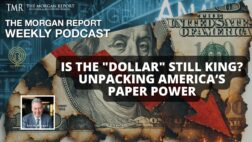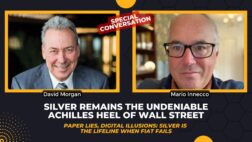A basic premise is that all we need to do to analyze the silver market correctly is to look at the supply. Of course demand is as important but let’s focus on the supply of silver and realize that according to the Silver Institute’s latest Silver Survey, in 2010 scrap supply reversed three consecutive years of losses as it registered a 14% increase to 215 million ounces. I bring this up because I recently was at an investment seminar and a woman from the audience insisted that there was not silver recycling! I do not know where she got the idea but I told the audience that roughly 200 million ounces of silver is recycled each year.
These statistics can be taken at face value, but as Franklin Sanders of the Money Changer has pointed out in his articles it is amazing how these figures get re-worked without any explanation whatsoever. Regardless, the point is supply is what we need to place our attention. It can be pointed out as I just spoke the Silver Institute that the “reworked” figures are do to new information being updated as some of the figures are projections and when the true numbers are known they are submitted and changes do take place.
Silver has been in a continuous primary deficit since at least 1990 according to this study (Silver Institute provided by GFMS) until 2007. At that time the total supply mining AND recycling was greater than total demand. At this point my personal thoughts on the matter will be set to the side, and we will merely look at the reported numbers.
Again, I wish to bring up the point that demand is far more important than supply. It is a fact that approximately 1.5 BILLION more ounces of silver bullion existed in 1980 when the price temporarily went to $50.00 per ounce.
Why? DEMAND my friends, yes demand for silver, call it investment demand, monetary demand, or I am scare to death of what this piece of paper might be worth tomorrow demand, but demand is what took the price higher.
Gold for example has a rather healthy demand and the amount of gold bullion supply is far in excess of the silver bullion supply. The Money Metals – gold and silver – have been recognized as stores of value for thousands of years of human history. Gold has certainly done its job; it has preserved wealth for those that have invested assets in this metal. Gold has appreciated in U.S. Dollar terms roughly the amount the Dollar has declined.
In other words, gold has maintained purchasing power.
Things are not all that well in the financial system these days to even mainstream publications. I read most of the periodicals that North Americans read, and many such as Forbes, Fortune, Business Week, and others state plainly that there are problems with the Social Security system and many pension plans are in dire straights. The BRIC countries have problems, the PIIGS have problems and on and on it goes.
In fact not only are America’s finances strained, but look around the world:
a major demographic tide of declining birthrates is pushing nations further and further away from the promises that they’ve made to seniors. As nations age, they have fewer and fewer workers to support more and more retirees.
The plain truth is –it is mathematically impossible to pay off America’s national debt!
Nations around the world are “grappling with the long-term affordability” of their pension systems, according to a World Bank report. China faces a demographic crunch. By mid-century, its population will be older, on average, than America’s, thanks to its one-child policy. Starting about 10 years ago, China responded by broadening a social security system and enlarging a private pension system of “enterprise annuities,” states Richard Hinz, coauthor of the World Bank report.
India, also with more than one billion people, has been trying to enlarge its pension system beyond that for civil servants and employees of sizable corporations to those occupied in the “informal” and small-business economy.
However what people should really be concerned about is what the Mises Institute recently pointed out in an article about Social Security. The article pointed out that there is a popular misconception that there is some kind of “full faith and credit” obligation on the part of Congress to honor these Social Security “bonds.” The plain and harsh truth is most have been led to believe that the current system is a retirement program funded with segregated entrusted assets, the integrity of which is guaranteed and backed by the U.S. government.
The debate about whether there is a Social Security cash flow crisis in 2017 or 2042 also turns on whether those “bonds” have any value. The basic assumption is that the “bonds” in the fictitious trust fund somehow have value either for the U.S. or for workers and their families.
As the Mises website article states: A bond is just a contract. A contract is an agreement between two or more parties that creates an obligation to do or not do a particular thing, such as pay out interest at a certain rate.
Thus, one may not enter into an enforceable contract with oneself, which is exactly what the U.S. is pretending to do with those social security “bonds.”
For a bond to be a real bond, there needs to be at least two parties; for example, the U.S. and a citizen who owns a U.S. treasury bond; or the U.S., as owner of a German bond, and Germany. The U.S. cannot issue “bonds” to itself and have their terms bind future Congresses.
Bottom line: These Social Security “bonds” are neither assets of the U.S.
nor property of workers and their families. In the not too distant future, you will have to ask yourself if the Social Security system will perform its function of providing any real security. You may decide to take action for yourself and depend on your own abilities. The ability of any government to be all things to all people is an illusion that will become a harsh reality to the general population over the next several years.
The $75,000 Social Security Solution
We know that we have many readers outside of the United States, and our discussion about Social Security may not affect them directly, but it could indirectly. Because so much of the world’s economic activity depends upon the spending power of the U.S., it should be factored into your thinking about the ramifications of the current situation.
Long-term studies of commodity prices have shown that over time, commodities return to their mean. This “average” price, however, can remain outside of this range for a very long time. Silver has certainly remained outside of its purchasing power range for the past 25 years, and remains so today.
Therefore we fully admit that having this knowledge for the past quarter-century was of little practical value. However, things are changing rapidly in the world’s financial landscape, and the new silver age is rapidly approaching, first from a technological standpoint and later from a monetary and wealth building/preservation perspective.
After Warren Buffett announced his silver purchase in 1998, Forbes magazine ran a brief article on silver and included a very interesting graph. (visit web site http://goldinfo.net/silver600.html) This graph provided 600 years of silver prices in 1998 dollars. So, all the inflation is taken out of the equation, and the prices reflect silver’s true value. In constant dollars, silver’s purchasing power averaged $150 per ounce in 1998 dollars for 600 years. This is the average purchasing power for 600 years; obviously, silver has nothing close to that “value” today, which provides one unbelievable investment opportunity.
Remember I made this forecast when silver was under $10! we are already up over 900% from the bottom and further to go– if you truly understand what is happening we may not be able to put a paper price on the precious metals.
Coming back to the Social Security discussion, what this system is supposed to do is provide a sufficient income stream to keep the contributors in a comfortable retirement for the rest of their days. The amount of $150 per day equals $4500 per month in purchasing power, or $54,000 per year-certainly not a huge income but sufficient in purchasing power for most Americans to retire upon. To obtain this level of income from “safe” T-bills would require over $3 million at 1.87% yield. Compared to 10,000 ounces of silver bullion that would cost roughly $75,000, it certainly is a risk profile that demands serious consideration. Very few of our readers will have three million in cash equivalents saved by the time they retire.
However, in this hypothetical study, if you did have that amount saved, a mere 2.3% weighting would be the $75,000, or about ten thousand ounces in silver bullion today.
Consider the fact that for centuries silver was used as money and the average worker earned roughly an ounce per day. One ounce of purchasing ($150) could be considered valid, using the 600-year average we are discussing. Ten thousand ounces is equivalent to 10,000 days, or, roughly, 27 years. This amount of silver would provide a safe retirement in days gone by-and perhaps a safe retirement in the future?
What makes this exercise so interesting is the amount of people that could actually secure their future in silver. With 103 million ounces on the Comex, only 10,000 people could own enough silver in historic terms (10,000 ounces). This theoretical demand is all it would take to buy the COMEX inventory!
Compare this to what Social Security holds, the perhaps 2 trillion in “bonds”. The amount of paper promises outstanding versus the amount of real money in the world is staggering, and at some point the two will start to close in on each other as a very small percentage of people wake up to the economic reality that has been pointed out by Paul Volker and even the World Bank. Simply, the world faces energy, monetary, and cultural problems ahead.
There truly is less silver than gold but, it is important to qualify this fact. First, this comparison is between gold bullion and silver bullion. In both cases, we are not talking about jewelry or art forms of the metals. However, to clarify the point, if silver coinage was added to the silver bullion, the total would still be approximately 1.5 billion ounces. This is less than one-third of the gold supply, if we count both gold coin and gold bullion.
Many people are now waking up to the silver situation is as bullish as is being presented. Many investors perhaps overlook this exercise. Gold is still held by many governments . . . silver is held by virtually none.
China and India do have some silver inventory, but it is considered to be minimal, at best. One easily verifiable fact is that the United States government is now totally out of silver at this point in time and now must go to the open market to purchase silver to continue its Silver American Eagle coin program. Think about this for a moment: The U.S. once held 2 billion ounces of silver . . . and now has none!
In studying the silver market for nearly my entire life, I have stated the conclusion there will not be a sustained or substantial increase in the price of silver until the physical supply is so small that the commercial users sense a coming shortage. Well guess what? We are there! At that point, silver will show price strength that few believe possible at this point. Why? Because, at that point, silver users in the defense, automobile and electronics industries will all be competing for silver at the same time that investors will sense the profit potential. It is with this understanding that I build my case that silver offers far more potential than gold.
David Morgan



